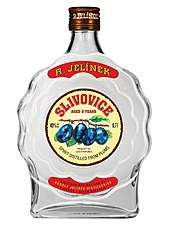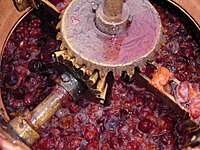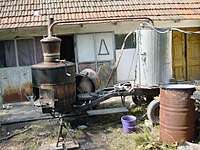Slivovitz
Slivovitz, slivovitza, Ssivovitsa, sliboviță, šljivovica, śliwowica, Schlivowitz, slivovice, slivovica or slivovka is a fruit brandy made from damson plums,[1] often referred to as plum brandy.[2] Slivovitz is produced in Central and Eastern Europe, both commercially and privately. Primary producers include Bosnia-Herzegovina, Bulgaria, Croatia, the Czech Republic, Hungary, Poland, Romania, Serbia, Slovakia and Slovenia. In the Balkans, slivovitz is considered a kind of rakia. In Central Europe it is considered a kind of pálinka (Czech Republic, Poland, Slovakia—pálenka, or Romania-pălincă), and similar to Romanian țuică, corresponding to the distilled spirits category.

Etymology
The word slivovitz is a borrowing from a shared Slavic word for plum or (more specifically) for damson plum:[3] Bulgarian: слива / sliva, Czech: slíva, Polish: śliwka, Serbo-Croatian: šljiva/шљива or Slovak: slivka + postfix -vice or -vica /vɪtsa/ to indicate the food from which it was distilled. For example, Czech meruňka apricot → meruňkovice apricot brandy; broskev peach → broskvovice peach brandy.
Production and consumption

The primary producers are Bosnia, Bulgaria, Croatia, Czech Republic, Hungary, Poland, Romania, Serbia and Slovakia.
Regional names
Following the claims of several nations to the protected designation of origin, in October 2007 the European Union went for a compromise solution, leaving "slivovitz" as a generic name, and granting individual nations the right to protect the origin with their own adjective.[4]
In respective languages, Slivovitz (/ˈslɪvəvɪts/) is known as: Bulgarian: сливова, сливовица; Czech: slivovice; Dutch: Slivovits,German: Sliwowitz, Slibowitz; Hungarian: sligovica; Italian: slivovitz; Macedonian: сливова; Polish: śliwowica; Romanian: şliboviţă; Russian: сливовица; Serbo-Croatian: šljivovica/шљивовица; Slovak: slivovica; Slovene: slivovka; Ukrainian: слив'янка; and Yiddish: שליוואָוויץ.
Identical or similar spirits are also produced in Austria, Canada, France, Germany, Switzerland, the United States, and regional names include generic plum brandy, Pflümli, or eau-de-vie de quetsche.
Distilling process
Only Damson plums may be used as the base fruit for distillation. During the production process, the plums and their ground kernels are crushed and pressed; yeast, starch, and sugar may be added to the juice. The mixture is then allowed to ferment. There may be one or more distillation stages, depending on the desired final product or region of production, and aging is common to enhance the distillate's finer flavours.
Some producers have obtained a Hechsher certifying that it is kosher for Passover,[5] and thus suitable for consumption during the festival when grain-based liquors are forbidden.[6]
Some modern production techniques, such as those used by Clear Creek in Oregon, omit the use of the pits in fermentation to create a less acerbic or bitter taste.[7]
Imitation slivovitz is made by flavouring spirits with prune juice and artificial oil of bitter almonds.[1]
History, by country
Bulgaria
In Bulgaria, the "Troyan plum brandy" (Troyanska Slivova) has been distilled in the Troyan Monastery by the monks since the founding of the monastery in the 14th century. The original recipe included 40 herbs, and was passed through the centuries from abbot to abbot. In 1894, the Monastery's brandy was presented at a spirits competition in Antwerp, Belgium, where it won a bronze medal. Some of its distinguishing characteristics include that it is made of a plum variety that only grows in the Troyan region, an old variety the locals call "Madzharkini plums", very juicy and aromatic whose stone, unlike the Teteven plums, is easily removed from the fruit; it is distilled in a vessel with a capacity of 80 to 120 litres; and only the best of the harvest is distilled. It is considered best distilled to an alcohol level between 39 and 41 degrees. Some celebrities who have tasted Troyan plum brandy are Pope John Paul II and former US President Bill Clinton. Patriarch Maxim of Bulgaria celebrated his 95th birthday in 2009 in the Sofia Metropolitanate with Troyan plum brandy.[8]
In cooperation with the Bulgarian government, the Czech distillery Rudolf Jelinek protected the brands "Troyanska slivova" and "Tetevenska slivova" in the EU in 2007. The same year, this largest European manufacturer of fruit distillates bought a majority share in the largest Bulgarian slivovitsa vinery "Vinprom-Troyan" after buying half a year earlier the second largest "Destila Teteven". However, the Czechs reduced the alcohol content to pay less duty. The production of "Vinprom-Troyan" is mainly for export. For the past 18 years, Troyan has a special holiday, The Festival of Plum.[9] This holiday is celebrated at the end of September in Troyan and in the village of Oreshak where the Troyan Monastery is located. The plum has always been an essential produce in this region. Since the beginning of the 20th century, plums have been made into marmalades, pesto, dried prunes, and pulps which were exported in Western Europe.[8]
Czech Republic and Slovakia

In the Czech Republic and Slovakia slivovice, or slivovica, respectively (as well as other fruit-based distilled alcoholic drinks) due to the somewhat symbolic status of the Moravian "national" drink is strongly presented in local traditions, culture and pop culture like in proverbs, songs, TV shows and movies.
Slivovice is primarily produced in the southern and eastern provinces of Moravia and in Vysočina, where the country retains its rural character. Although not legal, traditional moonshine home distilleries still exist, nonetheless, the majority of private production moved to certified local community-owned distilleries to prevent errors during the distillation process (leading to concentration of toxic methanol). Certified production also allows state authorities to collect respective taxes (based on the proof of the alcohol in the final product), however tax-reliefs for limited private and non-commercial production of the drink exist. The usual proof of private-produced slivovice is over 50% of alcohol in the final product, commercially available mass-produced slivovice is proofed less.
Slivovice is mostly served in small shot glass known locally as "panák" (literally: a dummy), "kalíšek" (colloquial for a small cup) or "štamprle" (from German "das Stamperl", a little glass). Keeping slivovice cold helps to reduce the effects of high proof; however, the drink is almost never served on the rocks. To enjoy the aroma and taste of the original fruit it is better and more common to drink slivovice at room temperature.
Poland
Poland has a long tradition of making Slivovitz. Historically it has been distilled in the southern regions of the country by local highlanders and not necessarily given any particular brand names. One of the more recognised of such products is Śliwowica Łącka associated with the region of Łącko.[10] Over the years, it was regarded as one of the best Polish Slivovitz. However, due to the fact that it is made without any specific control and brand ownership it has declined in quality, especially in recent years.[11]
Slivovitz was also distilled in large quantities by local Jewish communities in Poland mainly before World War II. As a popular Passover alcohol slivovitz had a strong standing among the traditional Orthodox communities in cities of Alexandrów, Stryków, Łódź, Warsaw, and Kraków. Since the end of World War II some state-owned distillers tried to reintroduce the Slivovitz based on Jewish traditions. Pejsachówka was a fitting example of that. The name of this slivovitz comes directly from the name of Passover holiday which in Polish is called Święto Paschy. At the end of communism in Poland (1989), Pejsachowka had disappeared from the market.[12] One of the Polish distillers created a brand called Śliwowica Paschalna. It was originally attempted as the relaunch of Pejsachowka, but has never reached the standards of its predecessor. This is because originally Pejsachowka was made only from plums, sugar, yeast and water. It is absolutely not allowed to be combined with any other spirit. Sliwowica Paschalna is slivovitz base mixed with grain spirit to achieve desired alcohol level and mostly to cut production cost. This means it cannot be kosher for Passover and certainly cannot be compared to Pejsachówka in quality. Another example is Śliwowica Strykowska which is made by a local distiller in cooperation with Łódź Jewish Community. Its brand in English is called Strykover Slivovitz. It holds a Kosher for Passover certificate. Its roots and concept is again tied with the traditions of Pejsachówka and Jewish heritage in past Poland.[13]
Serbia


Šljivovica (Serbian Cyrillic: шљивовица, pronounced [ˈʃʎîʋoʋit͜sa]) is the national drink of Serbia[14] in domestic production for centuries, and the plum is the national fruit.[15][16] Šljivovica has a Protected Designation of Origin (PDO). Plum and its products are of great importance to Serbs and are a part of numerous traditional customs.[17] A Serbian meal sometimes starts or ends with plum products and šljivovica is served as an apéritif.[17] A saying goes that the best place to build a house is where a plum tree grows the best.[17] Traditionally, šljivovica (commonly referred to as "rakija") is connected to a Serbian culture as a drink used at all important rites of passage (birth, baptism, military service, marriage, death, etc.).[17] It is used in the Serbian Orthodox patron saint celebration, Slava.[17] It is used in numerous folk remedies, and is given certain degree of respect above all other alcoholic drinks.[18][19] The fertile region of Šumadija in central Serbia is particularly known for its plums and šljivovica.[20] In 2004, over 400 000 litres of šljivovica was produced in Serbia. In 2017, Serbia was the 5th largest producer of plums and sloes in the world.[21]
After legal disputes, following the compromise of 2007 "Serbian Slivovitz" (Serbian: Српска шљивовица / Srpska šljivovica) became Serbia's first certified national brand.[22]
Šljivovica is consumed either directly from a leather-wrapped round bottle, or chilled in a shot glass called čokanjčić (plural: čokanjčići).[23] There is also a town in Zlatibor, called Šljivovica.[24][25] A popular print in Serbia depicts a moustached peasant wearing the šubara (fur hat), drinking šljivovica from a leather-wrapped bottle, with the motto: "Fuck the Coca, fuck the pizza, all we need is šljivovica".[26][27][28]
References
- Ward, Artemas (1911). "Slivovitz". The Grocer's Encyclopedia. New York. p. 567. Retrieved 2008-05-30.
- Haraksimová, Erna; Rita Mokrá; Dagmar Smrčinová (2006). "slivovica". Anglicko-slovenský a slovensko-anglický slovník. Praha: Ottovo nakladatelství. p. 775. ISBN 80-7360-457-4.
- slivovica in "Merriam-Webster Online Dictionary". Retrieved 13 February 2016.
- "Problemi oko izvoza šljivovice" (in Serbian). B92. 2007-10-01. Retrieved 2007-10-11.
- "Rudolf Jelínek: Kosher production". Archived from the original on 2007-11-17. Retrieved 2008-05-30.
- Ezra Glinter, Have Another Shot of Slivovitz, The Forward, March 30, 2012.
- https://neatpour.com/2019/10/plum-line-slivovitzs-past-future/
- "Тайните на Троянската сливова" (in Bulgarian). Десант. Retrieved 2010-09-22.
- "Марката "Троянска сливова" мина в чешки ръце" (in Bulgarian). Регал. Retrieved 2010-09-22.
- Gmina Łącko (2005-11-10), "Sliwowica lacka", lacko.pl, retrieved 2013-07-31
- "Uwaga podrabiana Sliwowica". fakt.pl. 2010-02-15.
- "Gorzelnia Siedlisko Pejsachówka". antyczek.pl. Archived from the original on 2013-07-31.
- Wioletta Gnacikowska (2011-04-19). "Jak Żyd z Polakiem Śliwowice pędzą". wyborcza.pl. Retrieved 2013-07-31.
- Goldstein, Darra; Merkle, Kathrin (2005-01-01). Culinary Cultures of Europe: Identity, Diversity and Dialogue. Council of Europe. ISBN 9789287157447.
- www.newmedia.rs, New Media. "Serbia Tourist Guide - Šljive". www.serbiatouristguide.com. Retrieved 2016-10-13.
- "The Leading Producers Of Plum In The World". WorldAtlas. Retrieved 2017-04-09.
- Stephen Mennell (2005). Culinary Cultures of Europe: Identity, Diversity and Dialogue. Council of Europe. p. 383. ISBN 9789287157447.
- POEZIJASCG. "POEZIJASCG - NJENOM VELIČANSTVU RAKIJI - Marko Lj. Ružičić". www.poezijascg.com. Retrieved 2016-10-13.
- Dujlovich, Berislav Branko; Goodreau, Berislav Branko Dujlovich with Michael (2006-03-20). Branko's Ride. Xlibris Corporation. ISBN 9781425703271.
- Grolier Incorporated (2000). The encyclopedia Americana. Grolier. p. 715. ISBN 9780717201334.
- "FAOSTAT". www.fao.org. Retrieved 2018-12-30.
- "Slivovitz becomes Serbia's first brand". B92. 2007-09-28. Archived from the original on 2011-06-06. Retrieved 2007-10-11.
- "Čuturice i čokanjčići hit među strancima". Vesti.rs.
- "Dossier "Šljivovica and Mitrovo Polje" - Fond za humanitarno pravo/Humanitarian Law Center/Fondi për të Drejtën Humanitare | Fond za humanitarno pravo/Humanitarian Law Center/Fondi për të Drejtën Humanitare". www.hlc-rdc.org (in German). Retrieved 2017-04-09.
- "Šljivovica, Serbia - Geographical Names, map, geographic coordinates". www.geographic.org. Retrieved 2017-04-09.
- Mario Aguirre; Francisco Ferrándiz (1 January 2002). The Emotion and the Truth: Studies in Mass Communication and Conflict. Universidad de Deusto. pp. 139–. ISBN 978-84-9830-506-7.
- Scott MacDonald (1 June 2013). American Ethnographic Film and Personal Documentary: The Cambridge Turn. University of California Press. pp. 298–. ISBN 978-0-520-95493-9.
- "Gaga "Srpkinja"!".
Sources

|title=(help)
External links
| Look up slivovitz in Wiktionary, the free dictionary. |
| Wikimedia Commons has media related to Slivovitz. |